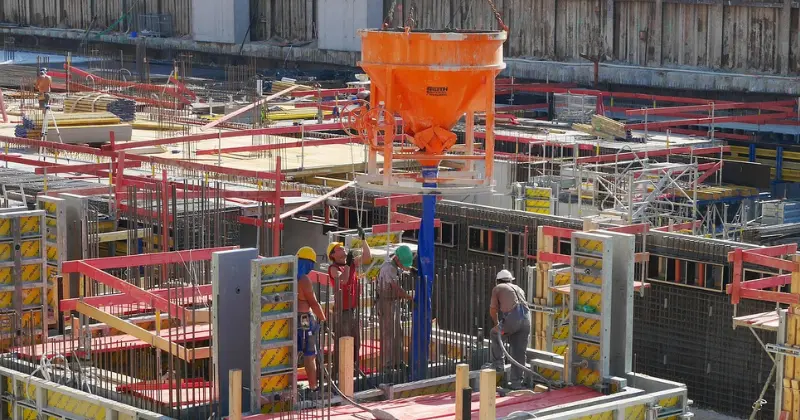11 mins read
What Is Preconstruction & Why Is It Important?
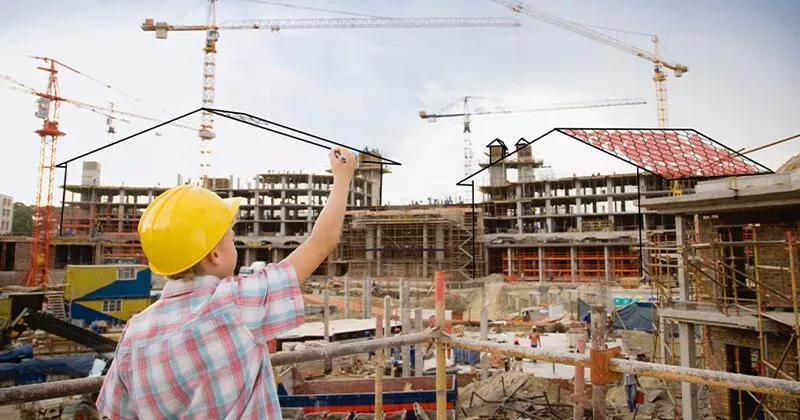
For any project to be successful, proper planning and a clear roadmap right from the start are essential. This is where preconstruction planning comes in – a strategic phase of a construction project that helps dictate the project’s profitability and identify opportunities that may affect profit margins.
Preconstruction planning has a significant impact on projects when it comes to completing them on time and within budget. It enables contractors to put the right processes and software in place from the very beginning of a project’s life cycle. This optimizes the whole preconstruction process before it even starts.
Proper planning can help to improve construction efficiency, reduce wasted time and energy, improve communications, and ensure that you hit the right profit margins.
It is a critical stage in a construction project, as it contributes to fewer delays, better resource management, and happy customers if done correctly.
What Is Preconstruction?
The word preconstruction refers to all the steps that are taken before the actual work is started on the site. During this phase, engineers, architects, and other construction roles team up and turn over complete project schedules, cost estimates, and drawings.
There are various activities involved in preconstruction that include, but are not limited to, procurement planning, environmental assessments, zoning reviews, and a site assessment. Effective preconstruction management that identifies potential barriers, leverages available resources, and sets specific aims and expectations is a fundamental part of successful construction projects. Many people simply look at the construction phase of a project, but the preconstruction process is just as essential.
During the preconstruction phase, a strategic plan is created and put in place. This plan needs to cover every element of the project ahead and include:
- Construction cost estimation and budgeting.
- A finalized design.
- A building timeline.
- The permitting process.
- Arranging the necessary labor and materials.
Basically, preconstruction planning is about laying a clear pathway for the project ahead to follow. This phase is about strategizing and implementing the plan for the construction to run smoothly without surprises.
What are the Preconstruction Roles?
During the preconstruction phase, various stakeholders are involved, each with their own specific roles and responsibilities. The primary preconstruction roles are the owner/developer, the design team, and the general contractor/construction manager.
Owner or Developer
At the start of the preconstruction phase, a feasibility study is normally conducted to identify the likelihood of the project’s success and financial viability. This is where the owner or developer enters the picture: They collaborate with the preconstruction team, including the engineer, to establish the project’s goals, financial constraints, and any other requirements necessary for project planning and design.
Design Team
Once the feasibility study is done, the preconstruction phase will proceed to the design stage. Here, the preconstruction team will collaborate with architects or designers and create preliminary plans, drawings, and specifications.
General Contractor/Construction Manager
The general contractor or construction manager is responsible for creating a thorough plan outlining the entire construction process, including precise scheduling, logistics, and resource allocation. They collaborate closely with the owner/developer and design team to optimize the project budget by providing precise cost estimates and highlighting potential opportunities for savings. Additionally, they may consult with specialized contractors (such as those in electrical or plumbing) during the preconstruction process to get their advice on particular project components, especially if there are any difficulties expected or unique processes involved.
Preconstruction Manager
Projects might also assign a dedicated preconstruction manager to focus on the unique aspects of risk management, budgeting, and planning that take place during the preconstruction phase. This role is tasked with identifying any potential issues that are apparent from the project plan, construction drawings, and specifications, and ensuring all work will be completed in compliance with relevant standards and regulations. The preconstruction manager might also identify ways to reduce costs without compromising quality, and interface with the client/owner to ensure their needs and expectations are understood.
Understanding the Preconstruction Phase
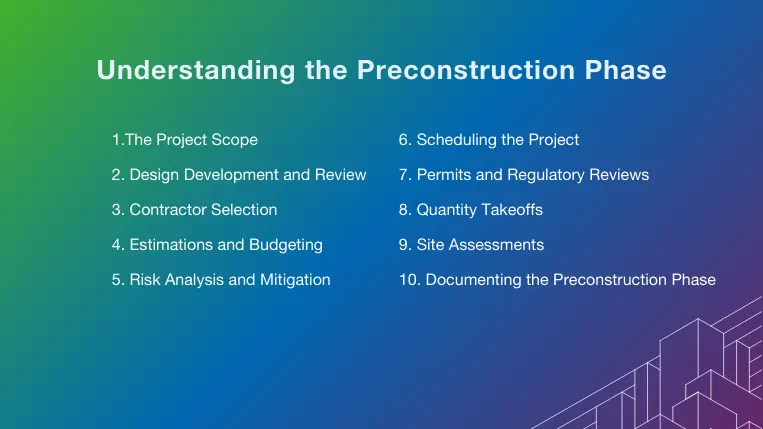
As a fundamental step for efficient project management in construction, preconstruction requires thoughtful planning and understanding of all aspects that go into it to ensure the rest of the project runs smoothly. Here are some of the main elements in the preconstruction process to consider.
The Project Scope
During the initial planning phase of the project, it’s important to get a full understanding of the project scope. This preconstruction management stage should involve a total review of all the project plans, specifications, data, and any possible constraints surrounding the project.
The very first planning stages are about creating a vision of the preconstruction process that will lead to the end result. This allows the contractors and clients to understand the kind of timeline and resources required for the project. It also provides a better understanding of the risks involved, the site planning, and design specifications.
Everyone involved in the build and design phases should start to become more familiar with the project and gain a better understanding of what they can expect to lie ahead. At this stage, companies implement professional construction management software to ensure all aspects of the project are managed from a centralized location.
Design Development and Review
Before starting the design development and review phase, the design team works closely with the owner/developer to refine the project’s conceptual concepts into precise drawings and specifications. In these comprehensive designs, the architectural, structural, mechanical, electrical, and plumbing systems are all included.
After the detailed drawings are completed, they go through a thorough review process where a variety of stakeholders, such as the project owner, prospective tenants, and regulatory bodies, offer insightful comments that may improve the design. Additionally, contractors can participate in design reviews to offer valuable input on aspects like cost estimation, installation, and the constructability of the design.
These evaluations make sure the designs can be constructed effectively and practically by spotting and fixing any possible problems before construction ever starts.
Contractor Selection
Once the design phase has been completed, it’s time to look for a capable contractor to carry out the design. Here, the owner/developer considers the contractors’ backgrounds, qualifications, and track record.
The owner’s team will usually outline the project’s scope, specifications, and expectations in a Request for Qualifications (RFQ), Request for Proposal (RFP), or Invitation to Bid (ITB). Following that, contractors will send in their bids, which will typically contain comprehensive designs, budgets, timetables, and qualifications.
The team will evaluate these proposals, do interviews, and run background checks to make sure the contractor is dependable and capable. All these steps are fundamental for efficient bid management in construction projects, as contractors need to be picked based on more than just the price they offer. The contractor’s capacity to coordinate, handle finances, guarantee high-quality work, and fulfill deadlines are important considerations in the decision-making process.
Estimations and Budgeting
To truly understand the project scope, you will need to have a realistic budget to work with. This will help you understand everything you need for the project to go ahead and what kind of limitations there may be.
The best way to reach accurate estimates is with specialized construction estimation software like RIB Candy. This helps you to create estimates faster and allows everyone on the team to access the relevant information. Having accurate estimates helps you to set a budget, from which proper resource planning and management can follow.
There is no way of being able to understand the full scope of the project without a realistic budget. This is an essential aspect of the construction project for both the contractors and the client. Therefore, focusing on getting estimations done as efficiently and effectively as possible is key in the preconstruction phase.
Risk Analysis and Mitigation
Risk analysis and mitigation are essential during the preconstruction phase. This process involves a methodical evaluation of a number of risks, including financial uncertainties, operations, safety, the environment, and schedules. The owner/developer, general contractor, and construction manager generally work together during this phase.
The team anticipates potential problems by using strategies like scenario planning, contingency planning, and SWOT analysis. After the risks have been identified, the team develops solutions for them, ranked according to likelihood and impact. These approaches could involve making design modifications for improved constructability, setting aside money for budgetary contingencies, putting strict safety measures in place, and creating backup schedules in case of unanticipated delays.
Scheduling the Project
Once you have understood all the project requirements, you can create a complete schedule of all tasks and processes that need to take place. This is important for outlining the project’s flow for the team and for tracking its progress during construction.
Having a clear and accurate preconstruction schedule is also a necessary tool for controlling and staying in line with the budget. Schedules help to keep timelines on track, maintain deadlines, track progress, and coordinate processes within the construction project.
Making sure that you draw up a clear schedule in the preconstruction phase is necessary for a streamlined construction operation to follow.
Permits and Regulatory Reviews
The importance of maintaining regulatory compliance and obtaining proper permits should never be underestimated, so it is important to include this work in the preconstruction process.
Permits ensure projects align with zoning requirements, building codes, and safety standards, since building without the right permits in place can lead to hefty fines or stop-work orders.
Regulatory reviews cover permitting issues along with topics like accessibility, environmental regulations, and design standards to ensure the project will comply with all relevant laws and regulations. Identifying and addressing any compliance gaps early helps to avoid delays that become more costly once work has started. Reviewing and documenting these issues also builds trust and confidence among clients and stakeholders.
Quantity Takeoffs
A quantity takeoff (QTO) uses project drawings, plans, or models to list and measure the materials and labor elements needed to complete a project.
The QTO is necessary to create accurate estimates and budgets, so it is advisable to perform this task during preconstruction, even if the final design and material details of the project are still taking shape.
The quantity takeoff enables detailed procurement planning, allowing for the identification of potential shortages or price hikes that may necessitate reconsidering material choices.
An accurate QTO also creates a baseline to weigh the cost impact of sustainable construction materials and other proposed changes and upgrades. This detailed analysis prevents the scope of work (SOW) from being underestimated.
Site Assessments
A thorough construction site assessment is another essential preconstruction task, since it helps to identify challenging issues like soil contamination, underground utilities, environmental hazards, and other problems with the potential to derail project progress, or even make a new site selection necessary. Early identification of site issues gives the team time to perform any additional cleanup, excavation, or layout revisions that are needed, and factor these activities into the project schedule.
Technology is making it easier to complete detailed and accurate site assessments, with drones equipped with high-resolution cameras surveying the landscape, and ground penetrating radar (GPR) identifying underground hazards that could lead to building or health concerns.
Documenting the Preconstruction Phase
The hustle and excitement experienced during the early stages of a project can make it easy to forget the importance of documenting all decisions, observations, and actions completed during this phase. Complete records will help contractors, subcontractors, engineers, or consultants who join the project during the building phase understand the challenges and gaps and develop strategies to address them.
Preliminary project plans that include the scope of work, tasks, and deliverables set the stage, while architectural drawings provide visual representations of the design concept and give stakeholders a more complete understanding. Results and findings from regulatory reviews, site assessments, quantity takeoffs, and other key preconstruction tasks should also be readily available for review.
The Importance of Preconstruction Planning
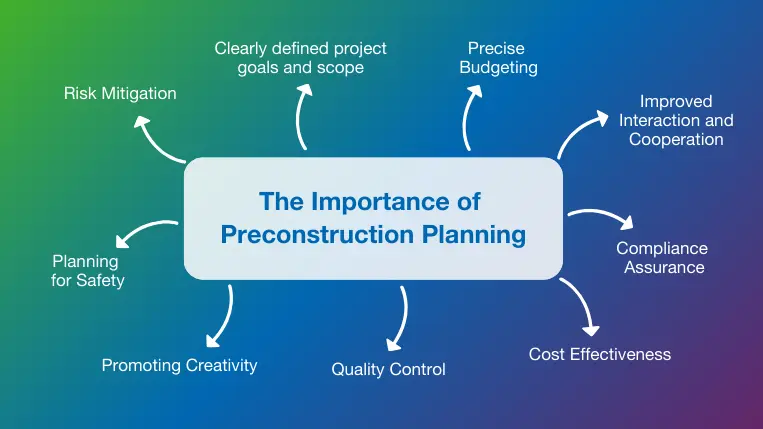
To ensure the construction project proceeds without hiccups, stays under budget, and satisfies all quality requirements, the planning phase includes careful organization, coordination, and preparation from all parties involved. Here are some advantages of preconstruction planning, as well as why it is so important.
Risk Mitigation
Arguably, the most important role that preconstruction planning plays is doing an early risk assessment. Teams can better anticipate issues and take action before they become serious ones by carefully examining every facet of the project. By being proactive, the risk of expensive delays, design mistakes, and budget overruns is decreased.
Clearly defined project goals and scope
Having a precise and comprehensive idea of the preconstruction schedule guarantees that everyone involved in the project is aware of its objectives, deliverables, and limitations. This helps avoid unforeseen expenses and longer project schedules.
Precise Budgeting
In-depth preconstruction cost estimates entail assessing every possible price and figuring out where costs might be cut without sacrificing quality. If you do proper budgeting, it will guarantee the project’s financial sustainability and prevent unforeseen financial difficulties.
Improved Interaction and Cooperation
Preconstruction planning promotes a culture of open communication and collaboration in construction projects – from clients and architects to preconstruction engineers and contractors. If you have frequent updates and meetings, it will guarantee that everyone is on the same page. This will minimize misunderstandings and improve teamwork.
Compliance Assurance
Construction projects have a lot of rules, codes, and permit needs to follow. By addressing all of these legal and regulatory concerns beforehand, the preconstruction phase helps to avoid any legal problems later on.
Cost Effectiveness
One of the benefits of preconstruction planning is that it can identify cost savings through thorough cost analysis and value engineering. Assess the various materials, construction techniques, and design options to identify the most economical ways to tackle the project while maintaining the best quality.
Quality Control
During the preconstruction phase, contractors establish quality standards and performance criteria to guarantee that the project meets or surpasses the customer’s expectations. This preconstruction checklist includes establishing standards for supplies, labor, and project results overall, which will increase client satisfaction and produce a better final product.
Promoting Creativity
The preconstruction planning process fosters a collaborative atmosphere that facilitates the sharing of knowledge and perspectives among stakeholders. The resulting project will be efficient and successful in achieving its objectives because of this synergy, which stimulates creativity and innovation in problem-solving.
Planning for Safety
It is safe to say that when it comes to building, safety comes first. Preconstruction planning includes creating detailed safety plans, spotting possible risks, and setting up procedures to guarantee a secure workplace. The site’s overall safety is improved, and the likelihood of accidents is greatly decreased by this proactive approach.
Common Challenges in the Preconstruction Process & How to Solve Them
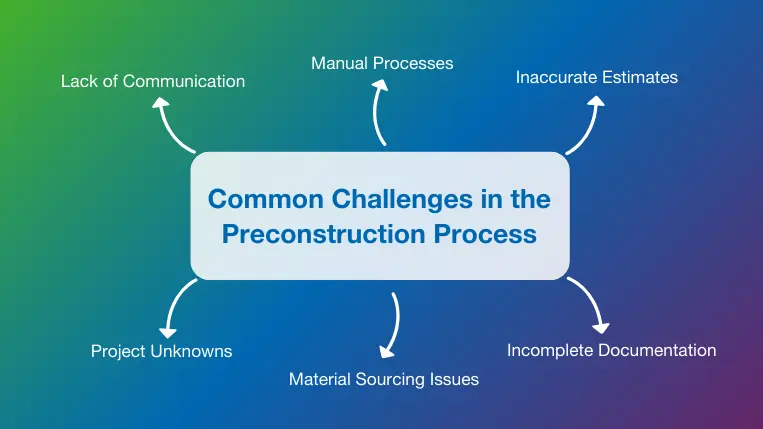
The preconstruction phase is when the project design and team begin to form, and there are many moving pieces that must come together perfectly to ensure success. Even experienced project owners, architects, and contractors experience some common pain points as they ramp up their activities.
Lack of Communication
The preconstruction planning process requires input from several different stakeholders, many of whom may be working together for the first time. Each person or team has their own preference for communication frequency and methods, which can make it difficult to get everyone on the same page early on. A new project might also require discussions to determine roles and responsibilities, which can also hinder the flow of information until this is resolved.
Technology issues can also present communication problems during preconstruction if some team members prefer digital communication methods like Email, mobile apps, and construction management software portals, while others are more comfortable with traditional phone calls and in-person meetings.
Manual Processes
Construction planning, estimation, takeoff, risk management, and change control processes are accelerated during the preconstruction phase, since the goal is to begin building as soon as possible while maintaining accurate records and calculations.
However, manual processes slow down the transition between the preconstruction and construction phases, with paper-based review and approval processes taking longer to complete and making it difficult to collaborate and answer questions in real time.
Manual processes can also introduce errors and delays that can propagate throughout the project life span. Most of these issues can be avoided with purpose-built software. If software tools are used to streamline the preconstruction process, they should be selected and implemented as soon as possible so the entire team can be trained proactively.
Inaccurate Estimates
While it is beneficial to create estimates and budgets as soon as possible, preliminary estimates can be less accurate than the detailed estimates completed later on, since there may be missing design, scope, material, or equipment information, and actual costs might differ between planning and construction dates.
It is important for all stakeholders to understand the limitations of these early estimates, and strive to provide as much information as possible to the estimators or contractors performing the calculations. Historical data can also be useful to baseline estimates against the actual cost of similar projects.
Incomplete Documentation
The early stages involve planning and coordination, as well as brainstorming and discovery, which means important decisions must sometimes be made without complete drawings, specifications, or documents in place. Time constraints and fragmented systems can also make it difficult to locate information, or ensure new document revisions are available to everyone who needs them.
Construction planners, estimators, and contractors understand these documentation issues and limitations. Still, they must also take steps to ensure errors, omissions, or conflicting documents are corrected prior to construction, to avoid costly delays, disputes, or regulatory compliance issues.
Material Sourcing Issues
Supply chain issues can be a major concern as the preconstruction schedule is established, with material shortages, price volatility, and transportation issues among the factors that must be considered early on to ensure the right materials will be available when they are needed. Digital procurement and forecasting tools can be useful to optimize ordering practices and control costs.
Green building practices bring their own set of material sourcing challenges during preconstruction. Sustainable materials often require detailed specifications with information on embodied carbon, volatile organic compounds (VOCs), and reusability, and each individual item plays a vital role in optimizing sustainability to attain REACH or BREEAM certification.
Project Unknowns
Material and design choices are among many variables that are impossible to predict or understand completely during the earliest project stages. Site conditions, weather events, labor shortages, and regulatory requirements are also subject to change at any time.
While these conditions can never be completely prevented, documenting project unknowns helps to mitigate risks, finalize decisions, and fill important gaps in information. Minimizing the number of unknowns also allows project teams to set more appropriate contingency budgets and schedules.
Tips For Efficient Preconstruction Management
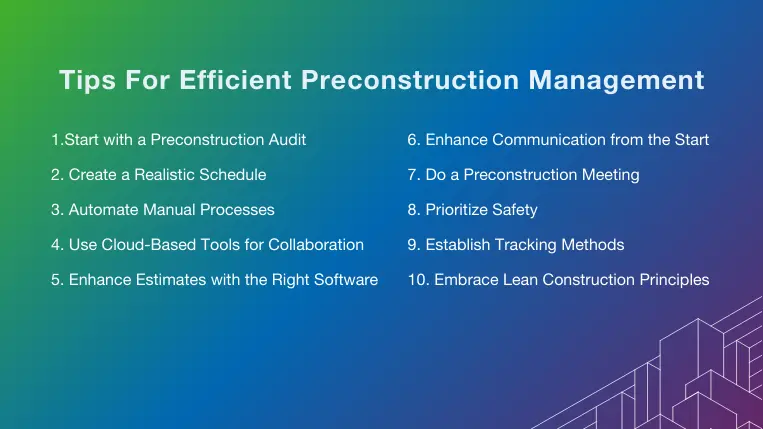
Start with a Preconstruction Audit
You may already have a clear preconstruction process in place. But is it adding value to your processes? Doing an audit of your current preconstruction process can help identify areas of weakness. It also assists you in understanding how to optimize your preconstruction planning to achieve greater success.
Discuss the planning processes with your whole team to identify pain points and weaknesses. Consider whether your teams work in silos and how effectively you store project information. Identify common mistakes that you can avoid in the future and investigate any missed deadlines. Also pay attention to manual tasks, such as data entry, that you can optimize.
Create a Realistic Schedule
All parties must work together to create clear communication in construction and define milestones and timelines throughout the preconstruction phase. You’ll need to establish reasonable timelines to obtain the necessary paperwork to begin the project, depending on your state, county, and city. Having effective preconstruction collaboration software can assist you in managing all of these deadlines.
Automate Manual Processes
One of the easiest ways to optimize preconstruction planning is by using the right construction management software. This takes care of time-consuming manual processes. The right software will automate these processes. Thus, it will save time and effort, and boost efficiency.
Construction software can handle all data entry for you. This gives construction teams the ability to handle larger workflows. They can spend more time focusing on important tasks, knowing that the tedious ones are handled.
Manual data entry also leaves room for mistakes. By automating this process with built-for-purpose construction software, you can ensure total accuracy in all the information and formulas used.
Use Cloud-Based Construction Software to Enhance Collaboration
Collaboration and communication are an essential part of effective preconstruction planning. To optimize this, you need to use collaboration-friendly software. Cloud-based construction collaboration software allows all the stakeholders of the project to easily access the project data from anywhere at any time.
The right software tool will make sure that everyone is always on the same page. This enhances communication and improves collaboration. It ensures that the entire team stays on track throughout the construction process.
The right software doesn’t just improve accuracy and efficiency; it also allows teams to maximize their skills and expertise during each project.
Enhance Your Estimates with the Right Software
Preconstruction planning should involve a thorough evaluation of your estimates. Making sure that you create accurate construction estimates is one of the key areas for the success of a project. If there are any issues with cost or quantity estimates, it can have a major effect on the project to follow.
Using the right estimation software is essential here. This software should be compatible with any other construction planning tools you use. This will allow for a much smoother construction process.
Enhance Communication from the Start
Successful projects require clear, concise communication for a seamless experience. So, it’s important to employ effective communication practices right from the preconstruction phase.
Effective communication channels ensure that the right people can always reach each other. It enables people to access the information they need when they need it. Again, choosing a cloud-based construction tool assists in this process.
Teams can get in touch with each other no matter where they are. In addition, they will always be able to access the most up to date information.
Do a Preconstruction Meeting
When having a preconstruction meeting, the whole team can get a clearer understanding of the client’s objectives. During the meeting, you will discuss the goals and objectives that the owner/developer has set and outline any queries or problems raised by the client. In this way, you will understand the client’s vision for the project better, evaluate the project’s viability, and specify deliverables.
Prioritize Safety
Preconstruction is the ideal time to identify and eliminate obvious safety hazards from the site, develop safety policies and training practices, and implement technology that allows safety issues to be identified and corrected quickly. A thorough review of the design helps to identify any safety hazards stemming from heavy objects, high surfaces, sharp objects, or electrical hazards.
A review of material specifications is helpful to determine appropriate personal protective equipment (PPE) and other precautions. Construction software tools are also useful for reporting and tracking safety issues, and collaborating on solutions and preventive actions.
Establish Tracking Methods
Effective tracking methods for task completion, material consumption, equipment usage, resource allocation, and dozens of other project tasks and metrics improve decision-making and keep projects aligned with schedules and budgets. Getting these systems in place early on is advisable, since any glitches, training, or software compatibility issues should be resolved before any actual work begins.
Having these robust tracking systems and construction KPIs in place from day one will help to avoid any unplanned rework, quality issues, cost variances, and other problems that are harder and more expensive to resolve mid-project.
Embrace Lean Construction Principles
Lean construction concepts are focused on reducing waste, improving efficiency, and eliminating unnecessary activities. Some of the most important activities related to lean implementation, such as value stream mapping and target value design, should be done early on to maximize their value and support the lean construction activities that follow.
Prefabrication, standardized workflows, and just-in-time inventory management are lean concepts that have moved from the manufacturing shop floor to the construction jobsite. These practices are beneficial at any point in the project, but their integration into early project planning activities ensures they have a positive impact on material planning and scheduling activities.
Final Thoughts
Identifying weaknesses during preconstruction is necessary for a more effective and efficient construction project ahead. With proper planning, contractors have a much greater chance of hitting the right profit margins and completing the project successfully.
Creating accurate estimates and budgets can also enhance construction management. Construction estimating software like RIB Candy, a cloud-based estimating, planning, and project control program, will ensure that you always stay on track with state-of-the-art technology that will take your results to the next level.
If you are ready to start building better, get a demo for RIB Candy today!
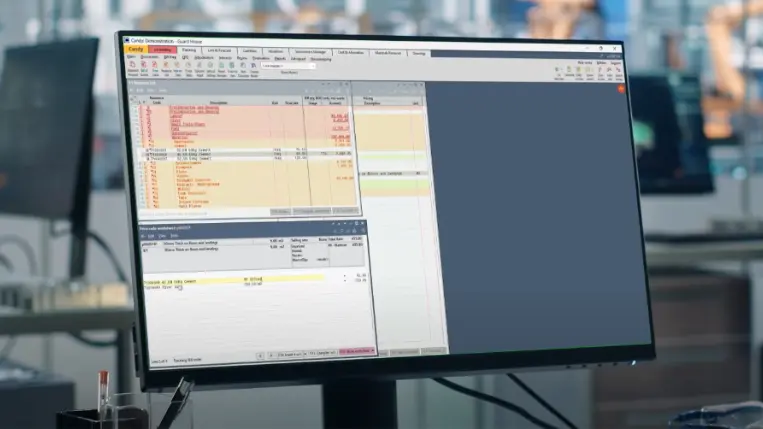
Most Recent
11 mins read
10 mins read
10 mins read
29 mins read
Blog Categories
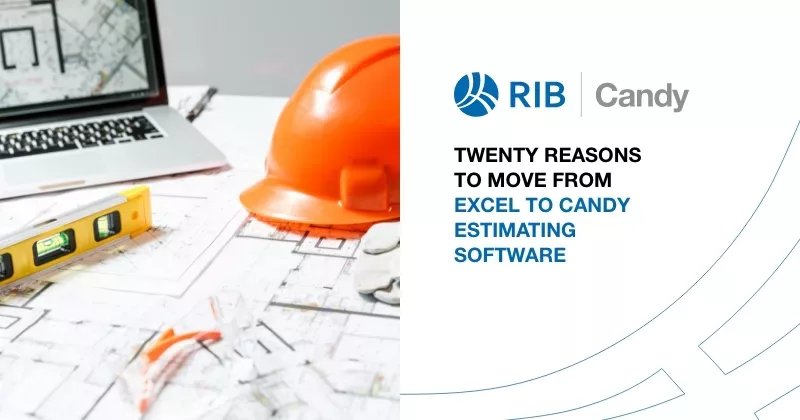
Ebook



